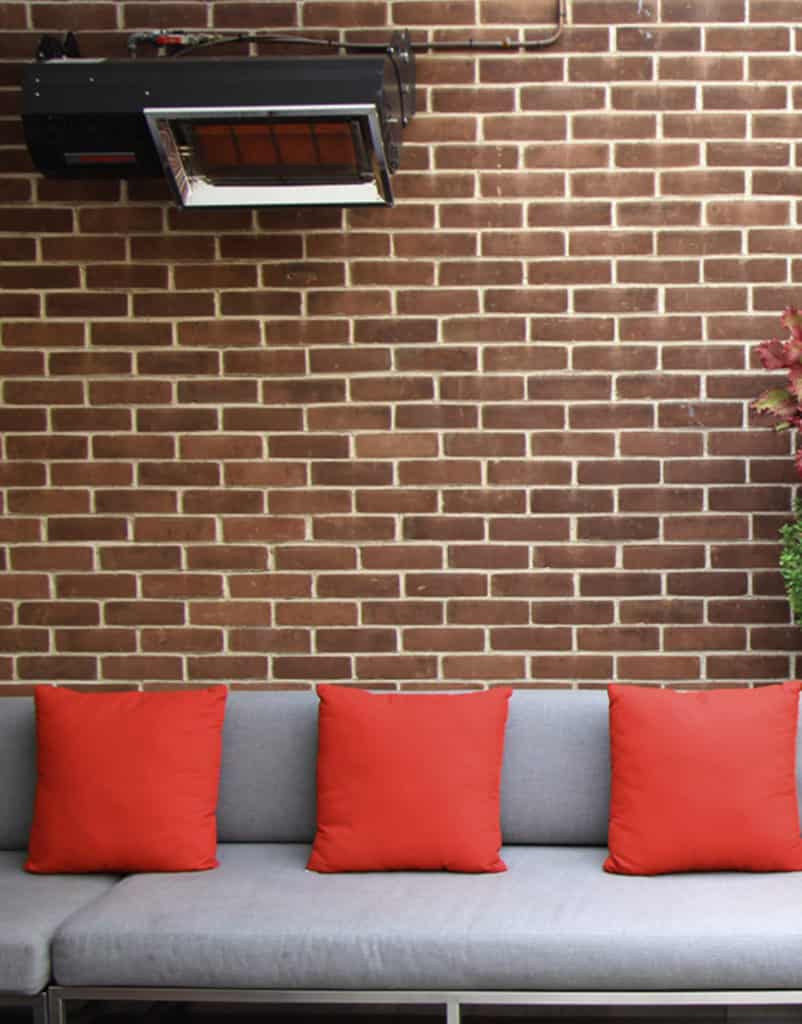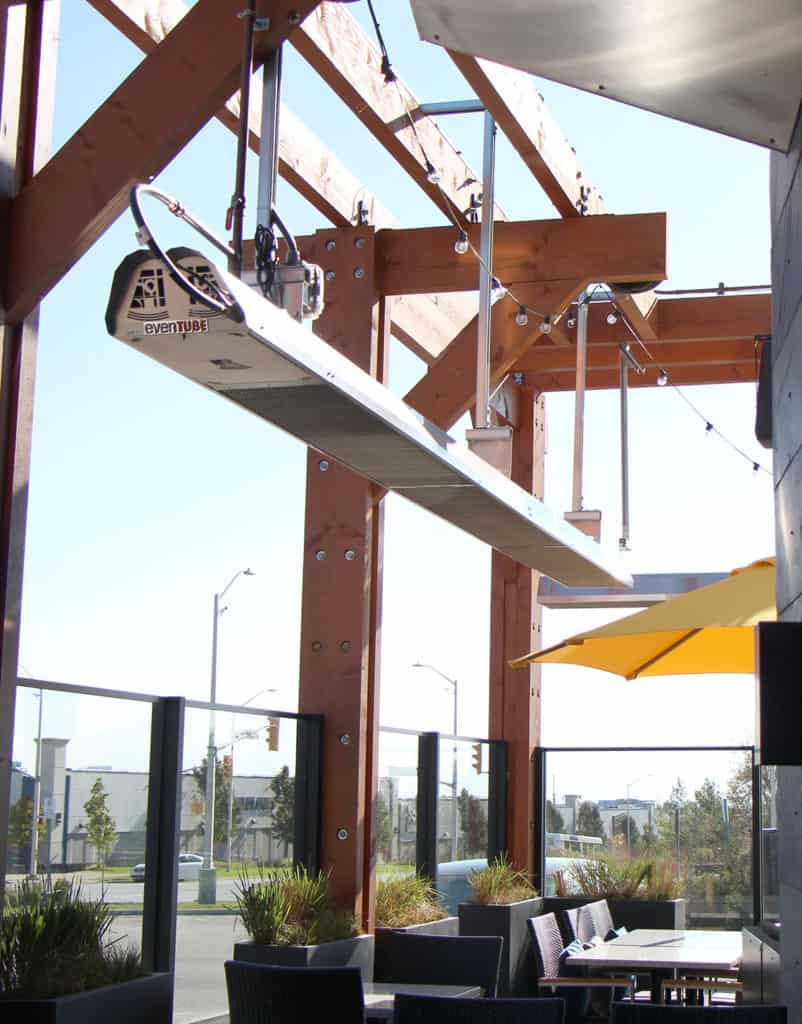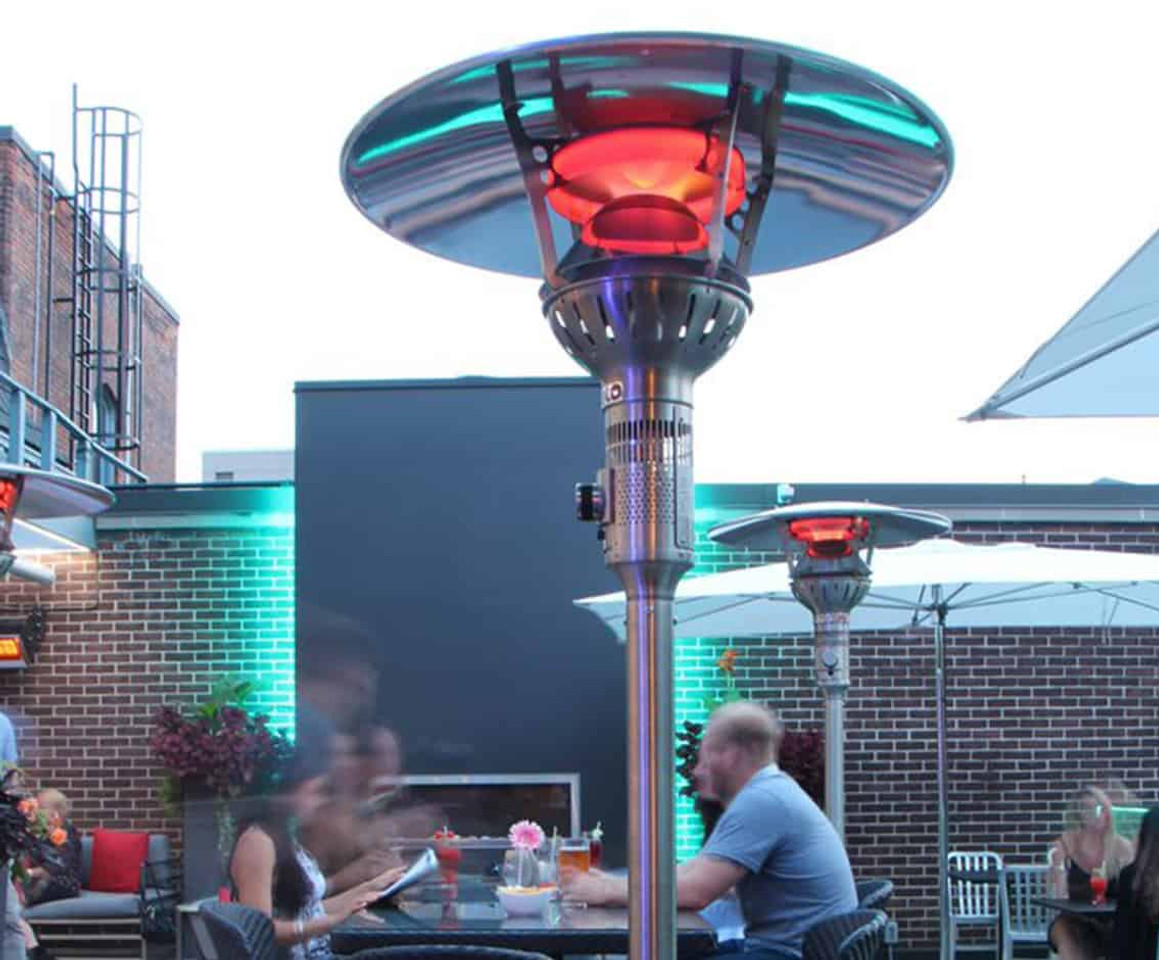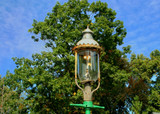How to Heat Your Outdoor Space: Gas vs. Electric Heaters
If you, like many others, want to use your oudoor spaces throughout the fall and winter months, you may be looking into outdoor patio heater options. But with so many options, how do you know which style is the best for your space? We’ll help you break down the differences to consider when deciding between gas vs. electric patio heaters.
Gas vs. Electric Patio Heaters: The Pros and Cons
Natural Gas Outdoor Patio Heaters
Natural Gas outdoor patio heaters are great options for homeowners or commercial spaces with a well-ventilated deck or patio space and existing gas lines.
Pros of Natural Gas Outdoor Patio Heaters
- Although they may be more expensive upfront, the long-term ownership costs of gas outdoor patio heaters are less than other systems.
- Gas patio heaters are typically easier to maintain in the long run.
- Because they connect directly to your existing gas line, gas patio heaters will offer continuous heat for as long as needed.
- Gas patio heaters offer a better heat output because of the combustion of natural gas, meaning your area will be warmer and heat up more quickly.
Cons of Natural Gas Outdoor Patio Heaters
- Wall mounted gas patio heaters require professional installation and a well-ventilated area for safety.
- Gas patio heaters require the installation of permanent gas lines and direct fuel source.
Propane Outdoor Patio Heaters
Outdoor propane heaters fall under the umbrella of gas heaters, but their operation isn’t dependent on a natural gas line or electricity.
Pros of Propane Patio Heaters
- Propane patio heaters are portable and maneuverable and allow for independent usage.
- Unlike fixed natural gas options, they offer flexibility and quick set-up.
Cons of Propane Patio Heaters
- Propane patio heaters require the purchase and replacement of propane tanks.
- Many systems require some assembly and hook-up.
Electric Outdoor Patio Heaters
For outdoor spaces that lack the proper ventilation required for natural gas or propane heaters, there is the choice of an electric outdoor heater.
Pros of Electric Patio Heaters
- They are easy to use — just place your heater where you want it, plug it in, and turn it on.
- Electric outdoor heaters are safe to use in smaller outdoor spaces, like enclosed patios.
Cons of Electric Patio Heaters
- Electric patio heaters require electricity and can only be used where there are electrical outlets nearby.
- Unlike natural gas or propane heaters, they have less output and are slower to heat up the space around them.
Which Is Cheaper To Run?
When weighing the options between gas vs. electric patio heaters, gas heaters undoubtedly offer a more budget-friendly approach for your outdoor heating needs. Unlike electric heaters, which can be limited in their heating capacity and efficiency, gas heaters can provide consistent, robust warmth at a lower operational cost. Whether you choose natural gas or propane, these heaters are designed for optimal energy usage, ensuring your outdoor gatherings are heated effectively without straining your finances. Gas patio heaters are the ideal solution for those prioritizing efficiency and economy, blending cost savings with reliable performance.
Outdoor Patio Heater Options
Portable, Free Standing Outdoor Heaters

The EvenGLO from American Gas Lamp Works
Because of the mobility of portable, free standing heaters, they are able to be used in a variety of different locations and can travel with you for parties or events. These heaters are available in both gas and electric options.
The EvenGLO from American Gas Lamp Works is available in portable natural gas or propane models that can stand alone or come as a hanging mushroom gas patio heater to maximize floor space.
Fixed, Wall-Mounted Heaters

The HABANERO M20 from American Gas Lamp Works
Available in gas and electric options, fixed, wall-mounted heaters are ideal for low ceilings, busy ceilings, and smaller areas.
The HABANERO M20 from American Gas Lamp Works is our smallest wall and ceiling mount gas patio heater, perfect for the conditions mentioned above.
Fixed, Overhead-Mounted Heaters

The EvenTUBE from American Gas Lamp Works
Fixed, overhead-mounted heating systems can come in both gas and electric models. These types of systems work well in areas with higher ceilings and have more intense and even heat footprints.
The EvenTUBE from American Gas Lamp Works is the sleekest tube heater on the market today. At less than 7” deep, it delivers a modern heating solution to any outdoor space and is effective for ceiling or wall heights from 9’ to 16’.
Gas vs. Electric Patio Heaters: Choosing The Right Outdoor Patio Heater
Consider Your Needs, Location & Frequency Of Use
As the first step when considering a gas vs. electric patio heater for your space, you should consider your needs and the frequency with which you’ll use your heater.
Are you a homeowner looking to heat the patio in your backyard, or are you a commercial business owner who wants to provide outdoor seating? Do you want a heater for enjoying time with your family, or do you want one that can accommodate restaurant seating and keep your customers warm?
You also need to ask yourself how often you’ll need to heat your outdoor space and how much your system will need to run.
Your location is also important — how cold can it get in your area?
Consider Your Outdoor Patio Space
The next step is to think about how much space you have and need to heat. There’s a simple calculation you can use to determine how many BTUs or how many patio heaters you need:
- Measure the cubic footage (length x width x height) of your patio or covered porch. (Pro tip: If your patio is uncovered, you’ll want to heat to a height of about seven feet.)
- Consider how cold it gets where you live versus your desired temperature for the patio.
- For example, if it’s 45 degrees F and you want to heat the patio to 75 F, your desired temperature increase is 30 degrees.
- Multiply your cubic feet total by your calculated desired temperature increase, and that’s the number of BTUs you need from your outdoor heater.
If you’re limited on space, have young kids or pets, or own a restaurant, hanging or flush mounted heaters will be your best option. If the location you’re looking to heat is partially indoors or is a screened porch, electric heaters are your best option.
Consider Outdoor Heating Costs
When thinking about gas vs. electric patio heaters, you need to remember that each outdoor heating system has different installation, output, and utility costs.
- Installation of gas lines — If you want natural gas heaters, but don’t have the gas lines, you’ll need to get them installed. This requires an upfront installation cost, but these heaters and lines are easy to maintain.
- Refill tanks — Propane heaters require the use of propane tanks, and that means that when the propane runs out, the tank needs replaced. This makes this type of heater a good option for infrequent needs, but the more frequently it’s used, the more frequently the tank will need to be changed.
- Electricity expenses — Electric outdoor heaters can be expensive to operate depending on the utility costs in your area and the high voltage outlets needed to run them.
We hope our breakdown of the different types of outdoor heaters will help you make an informed decision when considering gas vs. electric patio heaters. American Gas Lamp Works is proud to provide a range of IR Energy‘s top-tier gas patio heaters, known for their exceptional efficiency and innovative design.. If you still have questions regarding which outdoor heating option is best for your space, call/contact/chat with us, and we’ll be glad to answer any remaining questions you may have.







